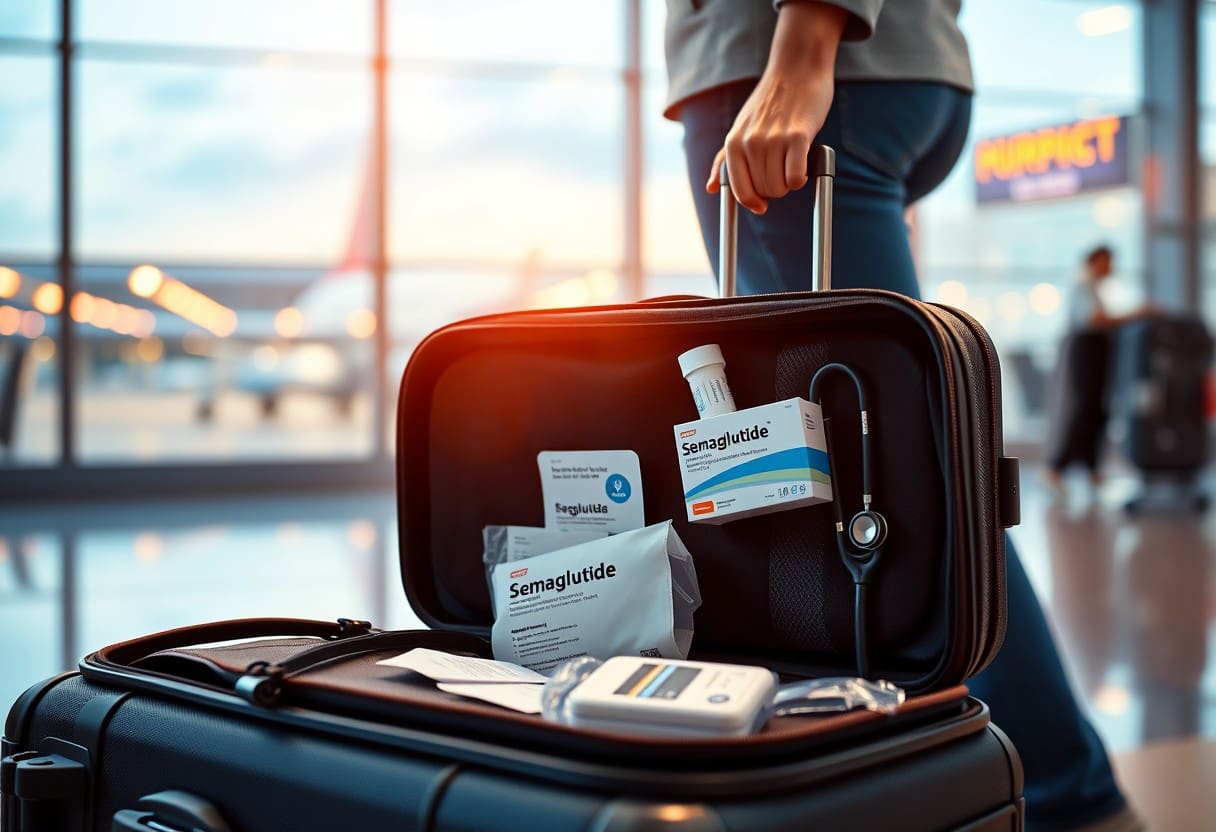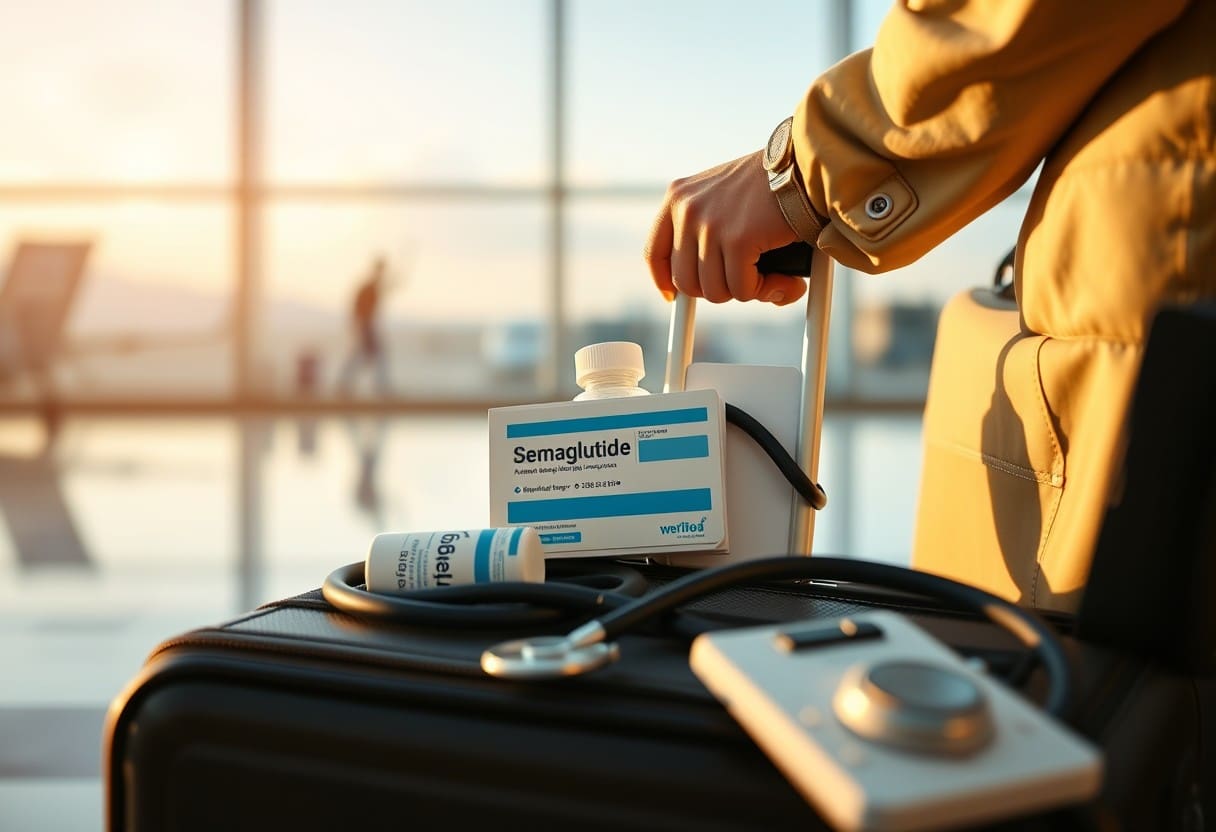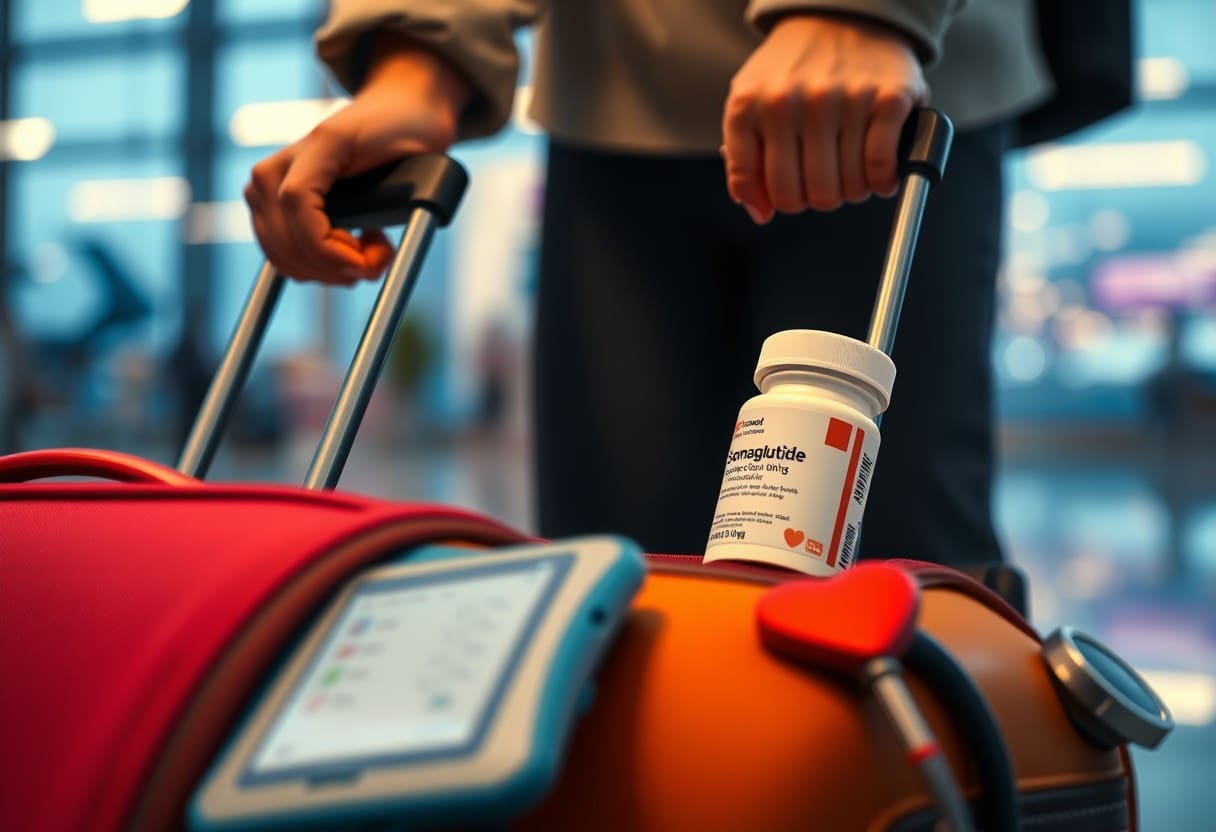Ah, the thrill of traveling! But, if you’re one of the many people taking GLP-1 medications like semaglutide or tirzepatide, you know that hitting the road (or skies) can be a bit more complicated. Don’t worry, we’ve got you covered! In this post, we’ll dish out all the necessary tips and tricks you need to know to travel safely and stress-free with your medication. From storing and transporting your meds to navigating airport security and crossing state lines, we’ll cover it all. So, buckle up and get ready for a worry-free adventure! And, if you have any questions or concerns, don’t hesitate to reach out to us at NJTrimClinic.com for a no-obligation consultation.
Key Takeaways:
- Proper Storage is Crucial: GLP-1 medications like semaglutide and tirzepatide require refrigeration to maintain their effectiveness. Use insulated bags and cooling packs to keep them within the correct temperature range when refrigeration isn’t available.
- Plan Ahead for Road Trips: Store your medication in an insulated bag with cooling packs, avoid direct sunlight, and refrigerate at overnight stops. Consider a portable mini-fridge for longer journeys.
- Train Travel Requires Planning: Carry your medication in an insulated bag, avoid checked baggage, and use cooling pads as needed. Check with train services for specific policies and assistance.
- Flying with GLP-1 Medications: Keep your medication in original packaging, bring a copy of your prescription, and declare it at security checkpoints. Keep it in your hand luggage and not checked bags.
- Crossing State Lines and International Travel: GLP-1 medications are not controlled substances and are allowed across state lines and internationally. Check specific regulations for each country and transit countries during layovers.
- Time Zone Changes: Maintain consistency in the day of the week you take your medication when traveling across time zones. Consult your doctor if you have concerns or if your travel schedule makes this challenging.
- Don’t Skip Medication on Vacation: Pausing GLP-1 medications can lead to the return of symptoms or conditions. Consult your doctor before pausing any medication, and understand the impact it may have on your health.
If you have any questions or concerns about traveling with semaglutide or tirzepatide, consider consulting with a healthcare professional at NJTrimClinic.com for a no-obligation consultation.

What are GLP-1 and GIP Medications?
Before we probe the intricacies of traveling with these medications, let’s take a step back and understand what GLP-1 and GIP medications are.
Definition and Classes of Medications
Medications like semaglutide and tirzepatide belong to a class of drugs called glucagon-like peptide-1 (GLP-1) and glucose-dependent insulinotropic polypeptide (GIP) receptor agonists. These medications are designed to help treat conditions such as type 2 diabetes and obesity. Within the GLP-1 class, there are several different drugs, including liraglutide, semaglutide, and dulaglutide. Tirzepatide, on the other hand, is both a GLP-1 and GIP receptor co-agonist.
If you’re interested in learning more about GLP-1 medications, you can check out our blog post on the topic. For now, let’s focus on how these medications are administered and what that means for traveling.
Administration Methods
For medications like semaglutide and tirzepatide, there are two primary administration methods: subcutaneous injections and oral pills. In this post, we’ll focus on the subcutaneous injection method, as it presents unique challenges when traveling.
For those using subcutaneous injections, it’s imperative to understand how to store and transport your medication safely. This includes keeping your medication refrigerated, using insulated bags with cooling packs when necessary, and avoiding direct sunlight.
Another important consideration is the potential need for refrigeration during your journey. Whether you’re traveling by car, train, or plane, you’ll need to ensure your medication remains at the right temperature. This might involve using a portable mini-fridge or taking advantage of ice provided by train services like Amtrak.
Are you considering starting a weight loss journey with GLP-1 medications like semaglutide? Contact us at NJTrimClinic.com for a no-obligation consultation to learn more about how our team can support you.

Storing GLP-1 Medications
The proper storage of GLP-1 medications like semaglutide and tirzepatide is crucial to maintaining their effectiveness. When traveling, it’s crucial to understand the refrigeration requirements and temperature control measures to ensure your medication remains potent.
Refrigeration Requirements
On average, GLP-1 medications require refrigeration to preserve their active ingredients. However, there may be occasions when these medications will be out of a temperature-controlled environment for short periods. According to a study, your vial of medication is safe for up to 3 days at a temperature as high as 140 degrees Fahrenheit. Additionally, it can remain effective for a period of 1 week at room temperature.
However, to ensure maximum efficacy, we strongly advise refrigerating the vial as soon as you have the opportunity, and using an insulated bag and cold packs to help keep the medicine within the correct temperature range when refrigeration isn’t available.
Temperature Control When Traveling
Temperature Control Guidelines
| Temperature Range | Storage Time |
| Up to 140°F (60°C) | Up to 3 days |
| Room Temperature (around 70°F/21°C) | Up to 1 week |
Control is key when it comes to storing GLP-1 medications while traveling. Using insulated bags and cold packs can help maintain the correct temperature range, ensuring your medication remains effective.
Temperature Control Tips
| Tip | Description |
| Use Insulated Bags | Keep your medication in an insulated bag to maintain the correct temperature range. |
| Avoid Direct Sunlight | Direct sunlight can affect the efficacy of your medication, so keep it out of direct sunlight. |
Road Trip Storage Tips
When traveling by car, it’s crucial to store your medication properly to maintain its potency. Here are some road trip storage tips to keep in mind:
- Store your medication in an insulated bag, using cooling packs in warm weather.
- Position cooling packs carefully to avoid direct contact with the medication, preventing freezing.
- Keep the medication out of direct sunlight to maintain its efficacy.
- During overnight stops, refrigerate your medication at your accommodation.
- Consider investing in a portable mini-fridge that connects to your car charger for longer journeys or extreme temperatures.
- Recognizing the importance of temperature control, take necessary precautions to ensure your medication remains effective throughout your trip.
This attention to detail will help you enjoy a stress-free road trip while maintaining your health and well-being. If you have any concerns or questions about traveling with GLP-1 medications, consider consulting with a healthcare professional at NJTrimClinic.com for a no-obligation consultation.
This post has provided you with crucial tips and guidelines for safely traveling with GLP-1 medications like semaglutide and tirzepatide. By understanding the refrigeration requirements, temperature control measures, and road trip storage tips, you can ensure a seamless journey while effectively managing your health.

Traveling by Car with GLP-1 Medications
After hitting the open road, it’s crucial to prioritize the safe transportation of your GLP-1 medications, like semaglutide and tirzepatide. With some preparation and planning, you can ensure your medication remains effective throughout your journey.
Insulated Bags and Cooling Packs
Any seasoned traveler knows that temperature control is crucial when transporting GLP-1 medications. Invest in an insulated bag specifically designed for storing medications, and don’t forget to pack cooling packs, especially during warm weather. When using cooling packs, position them carefully to avoid direct contact with the medication, as this can cause freezing, which is just as harmful as overheating.
Remember to keep your medication out of direct sunlight, as this can affect its efficacy. By taking these precautions, you can ensure your medication remains stable and effective throughout your road trip.
Overnight Stops and Portable Mini-Fridges
MiniFridges can be a lifesaver when traveling by car, especially for those planning longer journeys or venturing into areas with extreme temperatures. Consider investing in a portable mini-fridge that connects to your car charger, providing a convenient and reliable way to keep your medication at the right temperature.
This investment can offer peace of mind, knowing your medication is safely stored and ready for use whenever you need it. During overnight stops, take advantage of the opportunity to refrigerate your medication at your accommodation, ensuring it remains effective for the duration of your trip.
This is especially important if you’re planning a long road trip or traveling through areas with extreme temperatures. By taking these precautions, you can ensure your medication remains stable and effective, allowing you to focus on enjoying your journey. If you have any concerns about traveling with GLP-1 medications, consider scheduling a no-obligation consultation with our experts at NJTrimClinic.com.
Traveling by Train with GLP-1 Medications
Once again, traveling with GLP-1 medications like semaglutide and tirzepatide requires some planning, but it’s definitely doable. Here’s what you need to know when taking the train.
Self-Administration and Accessibility
Medications like semaglutide and tirzepatide need to be self-administered, which means you’ll need to be capable of injecting yourself. Most train services, including Amtrak, require this capability. It’s crucial to keep your medication easily accessible, so avoid placing it in checked baggage. Instead, carry it with you in your hand luggage. Self-Administration and Accessibility Tips | Self-administration | Be capable of injecting yourself with your medication | | Accessibility | Keep your medication in your hand luggage, not checked baggage.
Maintaining Temperature Control
Temperature control is crucial when traveling with GLP-1 medications. Use insulated bags with cooling pads as needed to keep your medication within the correct temperature range. Amtrak provides ice for medication coolers and allows passengers to travel with dry ice, provided it meets certain packing conditions. Maintaining Temperature Control Tips | Use insulated bags with cooling pads to maintain temperature control | | Ice and dry ice | Amtrak provides ice for medication coolers and allows dry ice, following packing conditions | Pertaining to maintaining temperature control, it’s crucial to be prepared. Consider investing in a portable mini-fridge that connects to your car charger for longer journeys or extreme temperatures.
Train Company Policies and Assistance
One of the most important things to do before your train journey is to contact the train company to understand their policies and procedures for traveling with GLP-1 medications. Amtrak, for example, allows passengers to travel with dry ice, provided it meets certain packing conditions. They also provide ice for medication coolers. The train company can also offer assistance, such as providing a quiet area for self-administration or storing your medication in a refrigerated area. Don’t hesitate to ask about these services when you book your ticket or before your journey. If you’re unsure about traveling with GLP-1 medications, consider consulting with a healthcare professional at NJTrimClinic.com for a no-obligation consultation. They can provide personalized advice and guidance tailored to your specific needs.
Flying with GLP-1 Medications
For those who rely on GLP-1 medications like semaglutide and tirzepatide, flying can be a bit more complicated than for others. However, with some preparation and knowledge, you can navigate airport security and travel safely with your medication.
Original Packaging and Prescription
On the day of your flight, make sure to pack your GLP-1 medication in its original packaging, along with a copy of your prescription. This is imperative in case you need to provide proof of your medication at security checkpoints or during your journey.
It’s also a good idea to keep your medication and prescription in a clear, quart-sized zip-top bag to facilitate screening at security checkpoints. This will save you time and hassle when going through security.
Hand Luggage and Security Checkpoints
One of the most important things to remember when flying with GLP-1 medications is to keep them in your hand luggage, not your checked bags. This ensures that your medication remains accessible and at a consistent temperature throughout your journey.
When passing through security checkpoints, be prepared to declare your medication and provide your prescription for inspection. Your medication may be scanned separately, and agents may ask you questions about your medication.
A great tip is to consider wearing a medical alert bracelet or carrying a medical ID card that indicates you use injectable medications. This can help facilitate the security process and avoid any confusion.
TSA Guidelines for Unused Syringes
On the TSA’s website, you’ll find guidelines for traveling with unused syringes and other injectable medications. According to these guidelines, you’re allowed to bring these items in your carry-on bag, but you must declare them for inspection at security checkpoints.
The TSA recommends that you keep your medication and associated supplies, such as syringes and needles, in their original packaging to facilitate screening. You may also be asked to provide your prescription or a letter from your doctor explaining your medical condition and the need for these medications.
Flying with GLP-1 medications requires some extra planning, but by following these guidelines, you can ensure a smooth and stress-free journey. If you have any concerns or questions about traveling with your medication, consider consulting with your healthcare provider or scheduling a no-obligation consultation with our team at NJTrimClinic.com.
Crossing State Lines and International Travel
To ensure a smooth journey with your semaglutide medication, it’s crucial to understand the legal considerations and regulations surrounding state lines and international travel.
Legal Considerations for State Lines
Considerations for traveling with GLP-1 medications like semaglutide within the United States are relatively straightforward. Since these medications are not controlled substances, you can travel with them across state lines without worrying about legal repercussions. However, it’s always a good idea to keep your medication in its original packaging and bring a copy of your prescription, just in case.
Additionally, be aware that some states may have specific laws or regulations regarding the transportation of prescription medications. While these laws typically don’t apply to GLP-1 medications, it’s always better to be informed and prepared.
International Travel Regulations
Traveling abroad with your semaglutide medication requires some extra planning and research. Most countries allow the short-term importation of prescription medications, but it’s crucial to check the specific regulations of the country you’re visiting, including any transit countries during layovers.
This is especially important, as some countries may have restrictions on certain medications or require additional documentation. To avoid any issues, make sure to research the regulations of your destination country and consult with your healthcare provider if you have any concerns.
This is also a good opportunity to ensure you have all necessary documents, such as a letter from your doctor explaining your medication and dosage, as well as a copy of your prescription. Having these documents readily available can help alleviate any potential issues during your trip.
Best Practices for Traveling with Prescription Medicines
Medicines like semaglutide require careful handling and storage to maintain their efficacy. When traveling, it’s crucial to keep your medication in its original packaging and store it in a cool, dry place, away from direct sunlight.
International travel can be particularly challenging when it comes to storing your medication. Consider investing in a portable mini-fridge or insulated bag with cooling packs to keep your medication at the right temperature during long journeys.
International travel also presents an opportunity to review your medication storage and handling practices. Take this chance to ensure you’re following best practices, such as keeping your medication away from children and pets, and properly disposing of used needles and packaging.
If you have any concerns or questions about traveling with semaglutide or tirzepatide, consider consulting with a healthcare professional at NJTrimClinic.com for a no-obligation consultation. They can provide personalized guidance and help you prepare for a safe and successful trip.
Time Zones and Dosing Schedules
Now, let’s talk about navigating time zones while traveling with semaglutide. As you cross into new time zones, it’s imperative to maintain consistency in your dosing schedule to ensure the effectiveness of your medication.
Maintaining Consistency Across Time Zones
On a typical Monday morning, you take your semaglutide injection, but what happens when you travel to a new time zone and Monday becomes Tuesday? Don’t worry; a few hours’ difference in your dosing schedule due to a time zone change is usually not significant. The key is to maintain consistency in the day of the week you take your medication. For instance, if you usually administer your dose on a Monday, continue to do so in your new time zone. This approach ensures a regular interval between doses, keeping your treatment on track even as you cross time zones.
Bear in mind, consistency is key. Stick to your regular dosing schedule, and you’ll be able to enjoy your trip without worrying about your medication.
Consulting with Your Doctor for Personalized Advice
For personalized guidance on managing your semaglutide dosage while traveling, it’s always best to consult with your doctor. They can provide tailored advice based on your specific needs and travel plans. Don’t hesitate to reach out to them before your trip to discuss any concerns or questions you may have.
Across different time zones, your doctor can help you adjust your dosing schedule to ensure you’re taking your medication at the right time. With their guidance, you can enjoy a stress-free trip while maintaining your health.
If you’re unsure about how to manage your semaglutide dosage while traveling, consider scheduling a no-obligation consultation with our team at NJTrimClinic.com. We’re here to help you navigate the intricacies of traveling with GLP-1 medications and provide personalized advice to ensure your health and safety.
Skiping GLP-1 Medications on Vacation
Keep in mind that taking a break from your GLP-1 medications like semaglutide and tirzepatide during vacation might seem appealing, but it’s generally not recommended. Pausing these medications can lead to the return of symptoms or conditions they’re prescribed to manage.
Risks of Pausing Medication
Meds like semaglutide and tirzepatide are designed to help manage conditions like type 2 diabetes and obesity. When you pause these medications, you may experience a resurgence of symptoms, which can be detrimental to your health. For instance, if you’re taking semaglutide for weight loss, pausing it might lead to weight regain. It’s important to weigh the risks and benefits of pausing your medication with your doctor before making any decisions.
Moreover, pausing your medication can also impact your body’s ability to respond to treatment when you resume taking it. This might lead to adjustments in your dosage or even changes to your treatment plan. It’s crucial to prioritize your health and consult with your doctor before skipping your GLP-1 medications, even if it’s just for a short vacation.
Consulting with Your Doctor Before Pausing
For your safety and well-being, it’s important to discuss any plans to pause your GLP-1 medications with your doctor before doing so. They can help you understand the potential risks and benefits of pausing your medication and provide personalized guidance tailored to your specific needs.
Skiping your GLP-1 medications without consulting your doctor can lead to unintended consequences. Your doctor can help you develop a plan to safely pause or adjust your medication schedule, ensuring you stay healthy and safe during your vacation. Don’t hesitate to reach out to your healthcare provider for guidance – it’s always better to be safe than sorry!
If you’re considering traveling with GLP-1 medications and have questions or concerns, consider scheduling a no-obligation consultation with our team at NJTrimClinic.com. We’re here to help you navigate the challenges of traveling with these medications and ensure your health and safety while on vacation.
To Wrap Up
With these considerations in mind, you’re now well-equipped to initiate on your next adventure with confidence, knowing exactly how to safely travel with your semaglutide medication. Whether you’re hitting the open road, taking the train, or soaring through the skies, remember to prioritize temperature control, accessibility, and legal considerations. By doing so, you’ll ensure a seamless journey while effectively managing your health. And if you have any further questions or concerns, don’t hesitate to reach out to the experts at NJTrimClinic.com for a no-obligation consultation.
So, go ahead and book that dream trip, knowing that your semaglutide medication won’t hold you back. With a little planning and preparation, you can explore new horizons while maintaining your health and wellness. Happy travels!
FAQ
Q: What are GLP-1 medications and how do they work?
A: GLP-1 medications, such as semaglutide and tirzepatide, are classes of medicines that help treat conditions like type 2 diabetes and obesity. They work by mimicking the action of a natural hormone in the body, helping to regulate blood sugar levels and insulin production. To learn more about GLP-1 medications, check out our blog post. If you’re considering starting GLP-1 medication, schedule a no-obligation consultation with our experts at New Jersey Trim Clinic.
Q: How should I store my GLP-1 medications while traveling?
A: When traveling, it’s crucial to store your GLP-1 medications correctly to maintain their effectiveness. Use an insulated bag with cooling packs to keep your medication at the right temperature. Avoid direct sunlight and extreme temperatures. If you’re traveling by car, consider investing in a portable mini-fridge that connects to your car charger. For more tips on storing GLP-1 medications while traveling, read our blog post.
Q: Can I travel by train with GLP-1 medications?
A: Yes, you can travel by train with GLP-1 medications like semaglutide and tirzepatide. Most train services require you to be capable of self-administering your medication. Keep your medication in its original packaging and bring a copy of your prescription. Use insulated bags with cooling pads as needed, and contact the train company beforehand if you have any questions or concerns.
Q: What are the TSA guidelines for traveling with GLP-1 medications by air?
A: When flying with GLP-1 medications, keep them in their original packaging and bring a copy of your prescription. Declare your medication at security checkpoints, and be prepared for it to be scanned separately. The TSA allows passengers to travel with unused syringes and other injectable medications, but you may need to show your prescription.
Q: Can I travel across state lines or internationally with GLP-1 medications?
A: Yes, you can travel across state lines or internationally with GLP-1 medications like semaglutide and tirzepatide. These medications are not controlled substances and are not prohibited in any state. Always keep your prescription medicines in their original packaging, and check the specific regulations of the country you’re visiting, including any transit countries during layovers.
Q: What happens if I travel to another time zone with my GLP-1 medication?
A: When traveling across time zones with once-a-week GLP-1 medications, maintain consistency in the day of the week you take your medication. For example, if you usually administer your dose on a Monday, continue to do so in your new time zone. This approach ensures a regular interval between doses, keeping your treatment on track even as you cross time zones. If you have concerns, consult with your doctor for personalized advice.
Q: Can I skip my GLP-1 medication while on vacation?
A: It’s generally not advisable to skip your GLP-1 medication while on vacation. Pausing these medications can lead to the return of symptoms or conditions they’re prescribed to manage. Before pausing any medication, talk to your doctor to understand the impact it may have. There are ways to stop taking GLP-1 medicines safely, but these typically are used when weaning off the medicine completely, not for short-term breaks.
